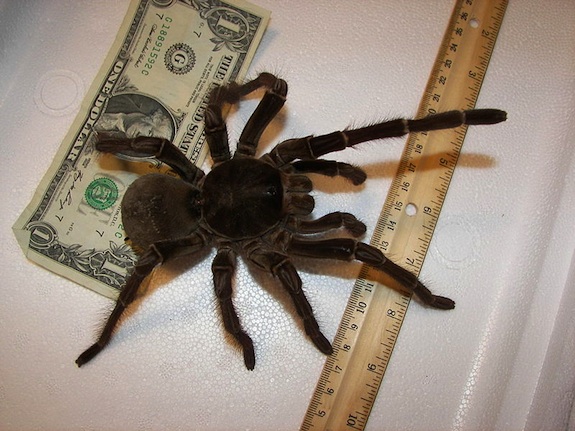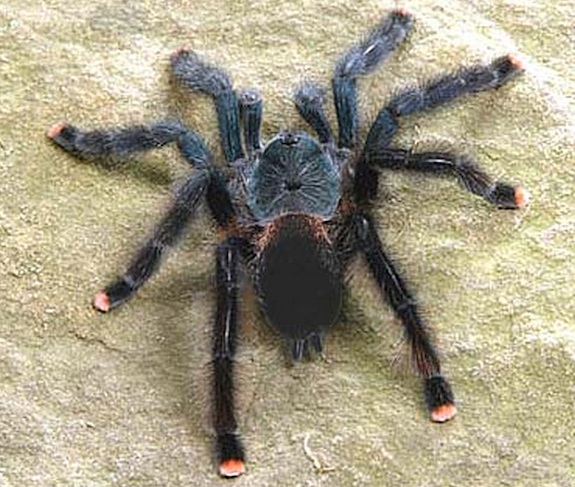Why We Should All Celebrate Save a Spider Day
Insect keeper Dan Babbitt of the Natural History Museum explains what makes spiders so cool
![]()

Fear-inducing or awe-inspiring? For more stunning shots of spiders, check out our Save a Spider Day slideshow. Photo by Thomas Vignaud
If you’re afraid of spiders, you’re in good company–at least according to the Wikipedia page on arachnophobia, which lists Justin Timberlake, Kim Kardashian and Jessica Simpson as sharing the affliction. As star-studded as the fear may be, however, it’s not particularly well-founded.
For example, one of the most infamous spiders, the brown recluse, has earned a terrible and outsized reputation for its supposedly deadly bite. Doctors often blame the species for spider bites, even in states where the brown recluse isn’t present. Researchers like Rick Vetter of the University of California, Riverside work tirelessly to clear the brown recluse’s name and fight “media-driven hyperbole and erroneous, anxiety-filled public hearsay.”

The brown recluse has few allies in its fight to clear its name. Photo by Br-recluse-guy, courtesy of Wikimedia
Vitter describes himself as, “a highly volatile arachnologist who is bloody tired of everybody claiming that every little mark on their body is the result of a brown recluse bite and who believe with a religious zeal that brown recluses are part of the California spider fauna despite the incredibly overwhelming evidence to the contrary.”
Even where the species is present, says Dan Babbit, insect keeper at the Natural History Museum Dan Babbitt, “They don’t often bite people–they’re recluses, they tend to hide.”
Growing up with nature, Babbitt says he was never afraid of spiders, but that he was definitely not wildly fond of them when he began working with them at the museum in 1998. After spending time with them, though, he’s come to appreciate their unique qualities and even species personalities, something he thinks all people can do and which National Save a Spider Day, held every March 14, helps encourage as well.
On any given day, the museum displays nine different spiders, while the remaining 40 rest in the laboratory where they can burrow and hide and do all the things they might not when on view.

For a sense of scale, a goliath birdeater tarantula by a dollar bill and ruler. Photo by Flickr user Snakecollector, courtesy of Wikimedia.

The pinktoe tarantula can climb, swim and even fly, kind of. Photo by Ron Taylor, courtesy of the Burke Museum
More often than not, visitors come seeking the much-maligned brown recluse and black widow, says Babbitt. Then they spot the crowd-pleaser, the Goliath bird-eating tarantula, whose body can fill your palm and whose legs can stretch up to 12 inches across. The species got its name from a Victorian explorer who witnessed one eating a hummingbird in the rain forests of South America.
Babbitt’s personal favorite is the pinktoe tarantula, a South American spider with pink-tipped legs that give the impression of freshly-painted nails. Because the pinktoe spider comes from the rainforest, it’s one of the few tarantulas that can climb trees, survive falls and even swim. Where other tarantulas would be killed by a drop of just a few feet, these spiders “can essentially parachute down” from the treetops.
Aside from their hidden talents, spiders also offer humans benefits in some surprising ways. Their venom has been used in research for new medicines, their super strong webs (ounce per ounce stronger than steel) are helping designers dream up new industry technology and they’ve even inspired artworks and clothing products.
There are even new spiders still being discovered, like when spelunkers found a previously unknown family since dubbed Trogloraptor, or cave robbers, in southern Oregon. Taxonomy and spider expert as well as associate director for science at the Natural History Museum John Coddington told the Associated Press the finding was unique: “To walk out in the woods and find an example of an ancient lineage that no one has ever seen before is special.”
We’re still a long way from ridding ourselves of arachnophobia, but Babbitt believes we’re improving “I think there’s a chance for spiders but it’s a tough one, it’s a big fear people have.” He says every time a new group of visitors crowds around the tarantula cage for one of the thrice-daily feedings held Tuesday through Sunday at the museum’s insect zoo, they come away with a new appreciation for the creature and its relatives.
“They still might not be the biggest fans of tarantulas but at least they’re starting to ask questions about them and they’re not wanting to immediately smash them or run away from them.”
And for more fun with spiders:
Check out a slideshow of eye-catching spiders from around the globe.
See how one photographer locks eyes (all of them) with spiders.
Check out a 3-D rendering of a spider that lived 300 million years ago.
Find out why urbanization may be supersizing spiders.
/https://tf-cmsv2-smithsonianmag-media.s3.amazonaws.com/accounts/headshot/Leah-Binkovitz-240.jpg)
/https://tf-cmsv2-smithsonianmag-media.s3.amazonaws.com/accounts/headshot/Leah-Binkovitz-240.jpg)